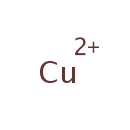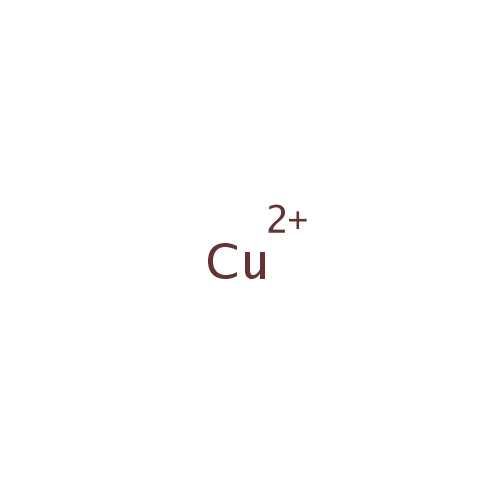
Copper (PAMDB000166)
| Record Information | ||||||||||||||||||||||||||||||||||||||||||||||
|---|---|---|---|---|---|---|---|---|---|---|---|---|---|---|---|---|---|---|---|---|---|---|---|---|---|---|---|---|---|---|---|---|---|---|---|---|---|---|---|---|---|---|---|---|---|---|
| Version | 1.0 | |||||||||||||||||||||||||||||||||||||||||||||
| Update Date | 1/22/2018 11:54:54 AM | |||||||||||||||||||||||||||||||||||||||||||||
| Metabolite ID | PAMDB000166 | |||||||||||||||||||||||||||||||||||||||||||||
| Identification | ||||||||||||||||||||||||||||||||||||||||||||||
| Name: | Copper | |||||||||||||||||||||||||||||||||||||||||||||
| Description: | Copper is s a ductile metal with very high thermal and electrical conductivity. Pure copper is soft and malleable; a freshly exposed surface has a reddish-orange color. The catalytic activity of copper is used by the enzymes that it is associated with and is thus only toxic when unsequestered and unmediated. Copper(II) ions are water-soluble, where they function at low concentration as bacteriostatic substances, fungicides, and wood preservatives. | |||||||||||||||||||||||||||||||||||||||||||||
| Structure | ||||||||||||||||||||||||||||||||||||||||||||||
| Synonyms: |
| |||||||||||||||||||||||||||||||||||||||||||||
| Chemical Formula: | Cu | |||||||||||||||||||||||||||||||||||||||||||||
| Average Molecular Weight: | 63.546 | |||||||||||||||||||||||||||||||||||||||||||||
| Monoisotopic Molecular Weight: | 62.929601079 | |||||||||||||||||||||||||||||||||||||||||||||
| InChI Key: | JPVYNHNXODAKFH-UHFFFAOYSA-N | |||||||||||||||||||||||||||||||||||||||||||||
| InChI: | InChI=1S/Cu/q+2 | |||||||||||||||||||||||||||||||||||||||||||||
| CAS number: | 7440-50-8 | |||||||||||||||||||||||||||||||||||||||||||||
| IUPAC Name: | copper(2+) ion | |||||||||||||||||||||||||||||||||||||||||||||
| Traditional IUPAC Name: | copper(2+) ion | |||||||||||||||||||||||||||||||||||||||||||||
| SMILES: | [Cu++] | |||||||||||||||||||||||||||||||||||||||||||||
| Chemical Taxonomy | ||||||||||||||||||||||||||||||||||||||||||||||
| Taxonomy Description | This compound belongs to the class of inorganic compounds known as homogeneous transition metal compounds. These are inorganic compounds containing only metal atoms,with the largest atom being a transition metal atom. | |||||||||||||||||||||||||||||||||||||||||||||
| Kingdom | Inorganic compounds | |||||||||||||||||||||||||||||||||||||||||||||
| Super Class | Homogeneous metal compounds | |||||||||||||||||||||||||||||||||||||||||||||
| Class | Homogeneous transition metal compounds | |||||||||||||||||||||||||||||||||||||||||||||
| Sub Class | Not Available | |||||||||||||||||||||||||||||||||||||||||||||
| Direct Parent | Homogeneous transition metal compounds | |||||||||||||||||||||||||||||||||||||||||||||
| Alternative Parents | Not Available | |||||||||||||||||||||||||||||||||||||||||||||
| Substituents |
| |||||||||||||||||||||||||||||||||||||||||||||
| Molecular Framework | Acyclic compounds | |||||||||||||||||||||||||||||||||||||||||||||
| External Descriptors |
| |||||||||||||||||||||||||||||||||||||||||||||
| Physical Properties | ||||||||||||||||||||||||||||||||||||||||||||||
| State: | Solid | |||||||||||||||||||||||||||||||||||||||||||||
| Charge: | 2 | |||||||||||||||||||||||||||||||||||||||||||||
| Melting point: | 1083 °C | |||||||||||||||||||||||||||||||||||||||||||||
| Experimental Properties: |
| |||||||||||||||||||||||||||||||||||||||||||||
| Predicted Properties |
| |||||||||||||||||||||||||||||||||||||||||||||
| Biological Properties | ||||||||||||||||||||||||||||||||||||||||||||||
| Cellular Locations: | Cytoplasm | |||||||||||||||||||||||||||||||||||||||||||||
| Reactions: | Cyclic pyranopterin monophosphate + Copper + 2 MoaD Protein with thiocarboxylate >5 Hydrogen ion +2 MoaD Protein with carboxylate + Molybdopterin 4 Copper + 4 Hydrogen ion + Oxygen >4 Copper +2 Water 4 Copper + 4 Hydrogen ion + Oxygen >4 Copper +2 Water Adenosine triphosphate + Copper + Water > ADP + Hydrogen ion + Phosphate + Copper Adenosine triphosphate + Copper + Water > ADP + Hydrogen ion + Phosphate + Copper Molybdopterin + Adenylated molybdopterin > Adenosine monophosphate + bis-molybdenum cofactor + Copper Adenylated molybdopterin + tungsten binding cofactor > Adenosine monophosphate + tungsten bispterin cofactor + Copper 2 Hydrogen ion + Molybdate + Adenylated molybdopterin > Adenosine monophosphate + Copper + Water + Molybdopterin -->-->NADH + Copper Hydrogen ion + NAD + Cu<SUP>+</SUP> Cu<SUP>+</SUP> + Hydrogen ion + Oxygen > Copper + Water Copper + NADH > NAD + Cu(+) | |||||||||||||||||||||||||||||||||||||||||||||
| Pathways: | ||||||||||||||||||||||||||||||||||||||||||||||
| Spectra | ||||||||||||||||||||||||||||||||||||||||||||||
| Spectra: |
| |||||||||||||||||||||||||||||||||||||||||||||
| References | ||||||||||||||||||||||||||||||||||||||||||||||
| References: |
| |||||||||||||||||||||||||||||||||||||||||||||
| Synthesis Reference: | Not Available | |||||||||||||||||||||||||||||||||||||||||||||
| Material Safety Data Sheet (MSDS) | Download (PDF) | |||||||||||||||||||||||||||||||||||||||||||||
| Links | ||||||||||||||||||||||||||||||||||||||||||||||
| External Links: |
| |||||||||||||||||||||||||||||||||||||||||||||
Enzymes
- General function:
- Involved in oxidation-reduction process
- Specific function:
- Transfer of electrons from NADH to the respiratory chain. The immediate electron acceptor for the enzyme is believed to be ubiquinone. Does not couple the redox reaction to proton translocation
- Gene Name:
- ndh
- Locus Tag:
- PA4538
- Molecular weight:
- 47.4 kDa
Reactions
| NADH + acceptor = NAD(+) + reduced acceptor. |
- General function:
- Involved in Mo-molybdopterin cofactor biosynthetic process
- Specific function:
- Involved in sulfur transfer in the conversion of molybdopterin precursor Z to molybdopterin
- Gene Name:
- moaD
- Locus Tag:
- PA3917
- Molecular weight:
- 9.2 kDa
- General function:
- Involved in Mo-molybdopterin cofactor biosynthetic process
- Specific function:
- Converts molybdopterin precursor Z to molybdopterin. This requires the incorporation of two sulfur atoms into precursor Z to generate a dithiolene group. The sulfur is provided by moaD
- Gene Name:
- moaE
- Locus Tag:
- PA3916
- Molecular weight:
- 16.7 kDa
Reactions
| Cyclic pyranopterin monophosphate + 2 [molybdopterin-synthase sulfur-carrier protein]-Gly-NH-CH(2)-C(O)SH + H(2)O = molybdopterin + 2 [molybdopterin-synthase sulfur-carrier protein]. |

